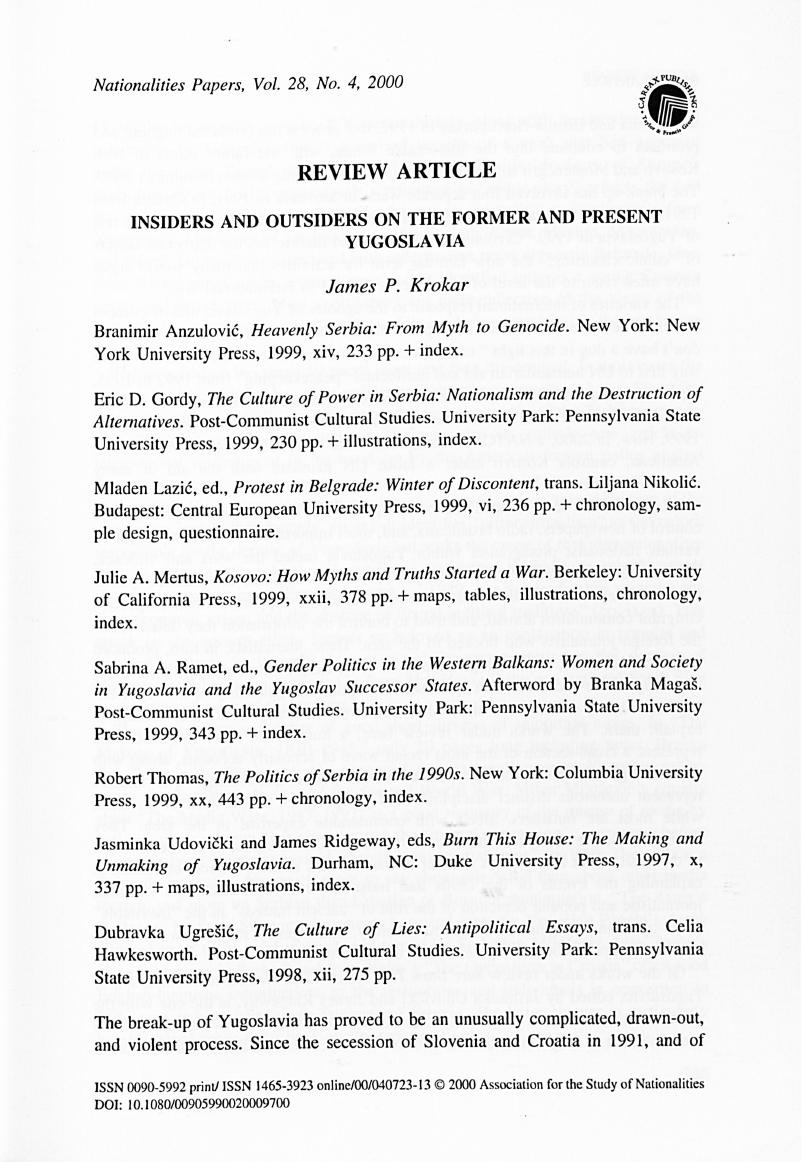No CrossRef data available.
Article contents
Insiders and Outsiders on the Former and Present Yugoslavia
Review products
Published online by Cambridge University Press: 20 November 2018
Abstract

- Type
- Review Article
- Information
- Copyright
- Copyright © 2000 Association for the Study of Nationalities
References
Notes
1. Among the best general accounts of the whole process of the break-up are two by journalists and one by a historian. The journalistic accounts, updated through the mid-1990s are Laura Silber and Allan Little, Yugoslavia: Death of a Nation (New York: Penguin, 1997), and Misha Glenny, The Fall of Yugoslavia: The Third Balkan War, 3d edn (New York: Penguin, 1996). The newest and most up-to-date account is the last 83 pages in the revised edition of John Lampe's account of Yugoslav history, including an entire new chapter on the years 1991–1999. John Lampe, Yugoslavia as History: Twice There Was a Country, 2d edn (New York: Cambridge University Press, 2000).Google Scholar
2. See, for example, Michael A. Sells, The Bridge Betrayed: Religion and Genocide in Bosnia, rev. edn (Berkeley: University of California Press, 1998).Google Scholar
3. The source of the Baker quote is Brent Scowcroft, quoted in Silber and Little, p. 201. On the international role in the break-up, for two differing views see Susan Woodward, Balkan Tragedy: Chaos and Dissolution after the Cold War (Washington: Brookings Institution, 1995), and James Gow, Triumph of the Lack of Will: International Diplomacy and the Yugoslav War (New York: Columbia University Press, 1997). On the most recent intervention in Kosovo, see Tim Judah, Kosovo: War and Revenge (New Haven: Yale University Press, 2000), and Michael Ignatieff, Virtual War: Kosovo and Beyond (New York: Metropolitan, Henry Holt & Co, 2000).Google Scholar
4. See Mark Thompson, Forging War: The Media in Serbia, Croatia, and Bosnia-Hercegovina (London: Article 19 International Centre against Censorship, 1994), and James Gow et al., eds, Bosnia by Television (London: British Film Institute, 1996). Tom Gjelten's Sarajevo Daily: A City and Its Newspaper under Siege (New York: HarperCollins, 1995) is a fascinating account of one newspaper's battle to try to maintain some objectivity.Google Scholar
5. Two of the best journalistic accounts are the Pulitzer-winning Roy Gutman, A Witness to Genocide (New York: Macmillan, 1993), on the camps in Bosnia, and Chuck Sudetic, Blood and Vengeance: One Family's Story of the War in Bosnia (New York: W. W. Norton, 1998), on how neighbors became enemies capable of atrocities.Google Scholar
6. Jasminka Udovički and James Ridgeway, eds, Yugoslavia's Ethnic Nightmare: The Inside Story of Europe's Unfolding Ordeal (New York: Lawrence Hill, 1995).Google Scholar
7. Unknown assailants murdered Ćuruvija in Belgrade in 1999, but his removal as co-author pre-dates that.Google Scholar
8. “Letters to the Editor,” Lingua Franca, February 2000, p. 7.Google Scholar
9. The Bridge Betrayed by Sells has a good list of sources for readers interested in checking the evidence themselves.Google Scholar




